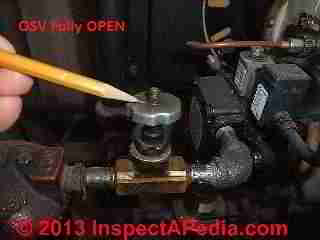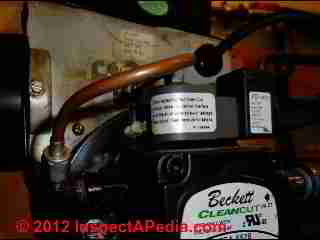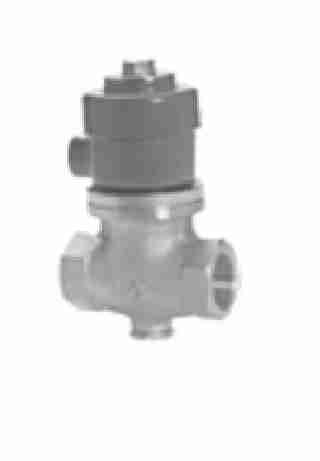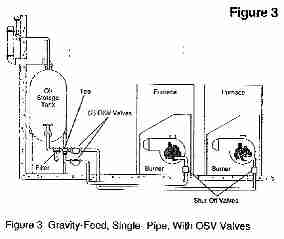 Definitions of Types of Oil Piping Controls & Valves
Definitions of Types of Oil Piping Controls & Valves
- POST a QUESTION or COMMENT about the definitions & functions of different valves & controls used on oil piping systems & at oil burners.
Oil Line Safety Valve (OSV) control types & definitions: this article illustrates & defines the different types of controls & valves used on heating oil piping systems, including check valve, fusible link valve, fire-o-matic type valve, vacuum operated valves, quickstop valves, solenoid valves, and oil delay valves.
We include links to details about the proper installation, use, & troubleshooting for each of these devices as well as manufacturers, brands, product sources.
InspectAPedia tolerates no conflicts of interest. We have no relationship with advertisers, products, or services discussed at this website.
- Daniel Friedman, Publisher/Editor/Author - See WHO ARE WE?
Definitions of Types of Heating Oil Line Control Valves
 Question: What is the difference among all these different kinds of valves used on oil piping and at the oil burner or oil tank
Question: What is the difference among all these different kinds of valves used on oil piping and at the oil burner or oil tank
What is the difference among all these different kinds of valves used on oil piping and at the oil burner or oil tank: check valve, fusible link valve, fire-o-matic type valve, vacuum operated valves, quickstop valves, solenoid valves, and oil delay valves. It's really confusing. - Anon 1/13/2012
[Click to enlarge any image]
Reply:
We agree that there are enough valves and enough similarity in their names that the controls used at oil tanks, on oil piping, and at the oil burner to manage the flow of oil can be confusing. Worse, valves that do different things and have different purposes may all be called "oil safety valves" in marketing and technical literature.
Don't confuse the built-in check valve in the fuel unit with external check valves, fusible link oil safety valves, solenoid operated quick-stop oil valves, and their sisters, solenoid operated oil delay valves.
Here is a list of the different types of controls & valves used on heating oil piping, oil burners, and at oil tanks in order to assure proper and safe flow of heating oil to oil-fired heating equipment such as boilers, furnaces & water heaters.
Oil line valves, check valves, oil safety valves or fusible link valves (OSVs), and de-aerators or air removing devices are all defined. We include links to individual articles giving details for the installation, operation, and troubleshooting of each of these oil line controls.
Anti-Siphon Valves on Oil Lines
 Shown at left is an anti-siphon valve sold by Envirosafe, #710 Series Solenoid Valve (Normally Closed).
Shown at left is an anti-siphon valve sold by Envirosafe, #710 Series Solenoid Valve (Normally Closed).
This anti-siphon valve is installed on the suction line exiting an above ground oil (or other liquid) storage tank to prevent accidental siphoning out of the tank should a leak occur in the piping downstream from the valve.
The valve is normally closed but will open when a dispenser pump is switched on. This product is provided by Envirosafe Above Ground Fuel Systems, 901 12th St., Clermont FL 34711, Tel: 800-555-4754, Website: http://abovegroundfuelstoragetanks.com, quoting:
Fuel Tank Check Valves:
Envirosafe™ Above-Ground Fuel Systems carries fuel tank check valves for above ground fuel tanks and other bulk fuel systems. We carry a variety of valves for bulk fuel tanks including vent valves, solenoid valves, by-pass valves, anti-siphon valves, and overfill prevention valves.
These [anti-siphon] valves are suitable for the dispensing of a variety of fuels including gas, oil, methanol, diesel, and alternative fuels.
See OIL SUPPLY LINE CHECK VALVES
Check Valves on Oil Lines: in-line check vales

An in line oil piping check valve is a simple one-way valve installed on an oil line to prevent backflow or leakage.
Installers often place a check valve on the return line to the oil tank in two-pipe oil system.
Watch out: as we explain in our OIL LINE CHECK VALVES article, some equipment manufacturers prohibit the use of these check valves in their systems.
Details about the uses & prohibitions of check valves on heating oil piping systems are
at OIL SUPPLY LINE CHECK VALVES On Heating Oil Lines
Some oil piping safety and valve controls combine features and use confusing names. Webster's OSV is a vacuum-activated check valve that both protects against overpressure at the fuel pump and protects against spills in oil piping by preventing oil flow if a leak is large enough to prevent the oil burner fuel pump from drawing adequate vacuum in the line .
See OIL SUPPLY LINE VACUUM-ACTIVATED OSVs & PRVs
De-Aerators or Air Removing Devices for Heating Oil Piping & Lines

De-aerators or prime protection fittings are special devices are available to protect heating oil piping and oil burners from loss of prime. The oil burner on an oil fired heating appliance can lose prime and thus stop working if there is air in the oil piping system.
Oil line de aerators operate by automatically removing un-wanted air from the oil piping system.
Air in the oil piping is likely to cause improper oil burner operation and can lead to loss of heat and also to dangerous
See OIL BURNER SOOT & PUFFBACKS
Details about oil piping de-aerators are
at TIGERLOOP™ or similar oil line de-aerator/prime-protection devices
Foot Valves in Oil Tanks
For some oil piping installations using No 2 home heating oil a foot valve may be installed at the suction line inlet in the oil tank; the foot valve acts much the same as a water well piping foot valve, keeping the oil piping system from losing prime by back-flow of oil out of the suction line into the oil tank when the fuel unit is not operating.
Fusible Link Oil Line Safety Valves - OSVs: fire protection device

Fusible link oil safety valves (OSVs) are installed in the oil piping to stop the flow of oil in event of a fire.
They are also a convenience for heating oil service technicians, allowing the service tech to turn off oil flow to change an oil filter or service the oil burner without creating an oil spill and a mess.
Details about OSVs are
at OIL SUPPLY LINE SAFETY VALVES, OSVs and
valve operation details are at OIL SUPPLY LINE SAFETY VALVE TURN DIRECTION to OPEN or SHUT
Really? the term OSV or oil safety valve can be a bit confusing because in addition to the fusible link type valve described here - a fire safety device - some companies use the term OSV or oil safety valve to refer to vacuum-operated devices intended to prevent oil line overpressure or to detect and stop oil line leaks.
We describe vacuum-operated oil piping valves below in this article; and for details about them
see OIL SUPPLY LINE VACUUM-ACTIVATED OSVs & PRVs.
Oil Storage Tank Overfill Protection Valves
 The valve illustrated at left (better image wanted) is Envirosafe's 9095S Series AST (Above Ground Storage Tank) Overfill Prevention Valve.
The valve illustrated at left (better image wanted) is Envirosafe's 9095S Series AST (Above Ground Storage Tank) Overfill Prevention Valve.
This device, available from abovegroundfuelstoragetanks.com (800-555-4754), is described by the supplier as follows:
Designed for use on low profile tanks that require a high level shut-off. The valve terminates the fill when the product reaches the preset level. The valve can be retrofitted on existing tanks and fits into a 2″ opening.
A tight fill connection is required for operation. Sold with either a 2″ Part F Male Threaded Adaptor or a 2″ Part A Female Threaded Adaptor.
Typical flow rate is 53 GPM at 30 PSI.
The company also provides a 9095A Series AST overfill prevention valve that is used i a "tight fill" application terminating flow into the tank when the tank reaches a pre-set warning level (90-95% full). The company notes that spill containers can be used for added spill protection around the oil tank.
Quick Stop & Oil Delay Valves at Oil Burners
Quick-stop valves and oil delay valves improve oil burner operation by eliminating the delivery of oil to the oil burner nozzle at low pressures.
Details about quick-stop or oil delay valves are
Vacuum Operated Check Valves, OSVs, or PRV Valves Prevent Oil Flow When the Oil Burner is Not Running

A PRV valve, such as Suntech Industries Inc.'s Model PRV-38 is an oil safety valve that prevents oil from flowing out of an oil tank by gravity, or by siphoning action, when flow is not desired.
At the inlet side of the PRV valve, oil can be supplied under pressure or under a vacuum (depending on whether or not the oil burner fuel unit is running). But the PRV will not open to allow oil to flow unless it senses a vacuum.
This means that oil will not flow past this valve unless the oil burner and its fuel unit are operating. The effect is that this valve prevents oil from flowing out of an oil tank under any other conditions.
Really? These vacuum operated valves are called OSVs - a term used also for fusible link fire safety valves discussed above. But vacuum-operated OSVs are leak and oil line pressure protection devices, not fir safety devices.
What's the difference between a fusible link "firematic" OSV valve and a vacuum-operated OSV?
In short, while a fusible-link Fir-o-matic type OSV valve provides fire protection at the oil burner, a vacuum-operated OSV or PRV provides protection against oil leaks and for some applications it protects against excessive oil pressure at the fuel unit.
Details are at OIL LINE VACUUM-ACTIVATED OSVs & PRVs - live link given just below.
...
Reader Comments, Questions & Answers About The Article Above
Below you will find questions and answers previously posted on this page at its page bottom reader comment box.
Reader Q&A - also see RECOMMENDED ARTICLES & FAQs
Question: Freeing up a stuck oil line control valve?
I think I have a valve that doesn't seem to turn off when fully turned counter clockwise. Any idea why? - P.C.
Reply:
If you have a fusible link valve that doesn't seem to turn off you might try tapping the exposed end of the valve stem. I have found a stuck, or slow to close OSV on a few rare occasions. A gentle tap, not hard enough to damage threads, loosens it after which I open and close the valve a few times to convince myself it now moves freely. A burr on the brass interior or more likely internal sludge or debris could be the culprit.
Because at the oil burner the OSV is likely to be used at least once a year during service, that's a good opportunity to discover if the valve is not closing fully.
...
Continue reading at OIL SUPPLY LINE VACUUM-ACTIVATED OSVs & PRVs or select a topic from the closely-related articles below, or see the complete ARTICLE INDEX.
Or see these
Recommended Articles
- BOILER CONTROLS & SWITCHES - full list
- COOLING & HEATING CONTROL & SWITCH INDEX
- DRAFT REGULATOR, DAMPER, BOOSTER
- ELECTRIC MOTOR OVERLOAD RESET SWITCH
- FIRE SAFETY CONTROLS - full list
- FURNACE CONTROLS & SWITCHES - full list
- OIL HEAT FIRE SAFETY CONTROLS
- OIL LINE QUICK STOP VALVES
- OIL SUPPLY & RETURN LINE CONTROLS & VALVES - full list
- OIL SUPPLY & RETURN LINE DE-AERATORS Tigerloop™
- OIL SUPPLY LINE PIPING LEAKS
- OIL SUPPLY LINE CHECK VALVES
- OIL SUPPLY LINE SAFETY VALVES, OSVs
- OIL SUPPLY LINE SAFETY VALVE TURN DIRECTION to OPEN or SHUT
- OIL SUPPLY LINE VACUUM-ACTIVATED OSVs & PRVs
- OIL or GAS FUELED HEATING EQUIPMENT SHUTOFFS
- STEAM HEATING SYSTEMS & Controls - full list
Suggested citation for this web page
OIL SUPPLY & RETURN LINE CONTROLS & VALVES at InspectApedia.com - online encyclopedia of building & environmental inspection, testing, diagnosis, repair, & problem prevention advice.
Or see this
INDEX to RELATED ARTICLES: ARTICLE INDEX to HEATING OIL, OIL BURNERS, OIL FIRED HEATERS, OIL TANKS
Or use the SEARCH BOX found below to Ask a Question or Search InspectApedia
Ask a Question or Search InspectApedia
Try the search box just below, or if you prefer, post a question or comment in the Comments box below and we will respond promptly.
Search the InspectApedia website
Note: appearance of your Comment below may be delayed: if your comment contains an image, photograph, web link, or text that looks to the software as if it might be a web link, your posting will appear after it has been approved by a moderator. Apologies for the delay.
Only one image can be added per comment but you can post as many comments, and therefore images, as you like.
You will not receive a notification when a response to your question has been posted.
Please bookmark this page to make it easy for you to check back for our response.
IF above you see "Comment Form is loading comments..." then COMMENT BOX - countable.ca / bawkbox.com IS NOT WORKING.
In any case you are welcome to send an email directly to us at InspectApedia.com at editor@inspectApedia.com
We'll reply to you directly. Please help us help you by noting, in your email, the URL of the InspectApedia page where you wanted to comment.
Citations & References
In addition to any citations in the article above, a full list is available on request.
- [1]AUDELS OIL BURNER GUIDE, INSTALLING, SERVICING, REPAIRING, [PDF online copy of this book] Frank D. Graham, Theo. Audel & Co., New York 1946, 1947, 1955 (out of print, copies occasionally available from antique book dealers and on EBay). Use THIS LINK to read a free online copy of this helpful classic textbook.
- [2] Beckett Model SR Oil Burner Instruction Manual, R.W. Beckett Corporation, PO Box 1289, Elyria OH 44036 and R.W. Beckett Canada, Ltd., 430 Laird St., Guelph, Ontario, Canada N1G 3x7
- [3] Thanks to Bottini Fuel service technician Bob for discussing the buzzing aquastat relay problem, 4/18/2012. Bottini Fuel is a residential and commercial heating oil distributor and oil heat service company in Wappingers Falls, NY and with offices in other New York locations. Bottini Fuel, 2785 W Main St, Wappingers Falls NY, 12590-1576 (845) 297-5580 more contact information for Bottini Fuel
- [4] Beckett Model SF Oil Burner Instruction Manual, op. cit.
- [5] Sunstrand Corporation - Sunstrand Fuel Units, 4949 Harrison Avenue P.O. Box 7003 Rockford, Illinois 61125-7003 U.S.A. Telephone: (815) 226-6000 Fax: (815) 226-5399 http://www.sundstrand.com
- [6] Sunstrand Transmission Service Manual, May 1974, web search 08/19/2011, original source: http://www.cushmantrackster.com/pay-pdfs/sundstrand.pdf - Sunstrand Series 15 hydrostatic transmissions
- [7] Webster Fuel Pumps & Valves, Capitol City Tool, Inc., http://www.websterfuelpumps.com/
- [8] Suntec Model A-7400 Fuel Unit Solenoid Dumping Pump,
Suntec Industries Inc., 60 Aberdeen Drive - PO Box 5000 Glasgow, KY 42142-5000 - USA Tel : 270 651 7116 - Fax : 270 651 9276 e-Mail : info@suntecpumps.com and
Suntec Industries France, 1 Rue Lavoisier - B.P. 102 F-21603 LONGVIC Cedex - FRANCE Tel : +33 (0)3 80 70 60 70 - Fax : +33 (0)3 80 70 61 11 e-Mail : information@suntec.fr, [copy on file as /heating/Oil pumps fuel units/Sunted_Solenoid_DumpingPPump.pdf] ,
Also /Suntech_Solonoid_Safety_Valves.pdf (brochure)
web search 4/19/12, original source: http://www.suntecpumps.com/Suntecus/PDFs/Form%202740%20
-%20Solenoid%20Dumping%20Pump.pdf - [9] Suntec Model PRV-38 Oil Safety Valve Installation Information, Suntec Industries Inc., 60 Aberdeen Drive - PO Box 5000
Glasgow, KY 42142-5000 - USA
Tel : 270 651 7116 - Fax : 270 651 9276
e-Mail : info@suntecpumps.com and
Suntec Industries France, 1 Rue Lavoisier - B.P. 102 F-21603 LONGVIC Cedex - FRANCE Tel : +33 (0)3 80 70 60 70 - Fax : +33 (0)3 80 70 61 11 e-Mail : information@suntec.fr, [copy on file as /heating/Oil pumps fuel units/Form 2155 - PRV-38 Installation.pdf]. You can download this file from Suntec's website. , - [10] Firomatic Globe Type Oil Line Valves & Lever Type Fusible Link Control Valves: ISP Automation, Inc., 1035 Old Georges Road, North Brunswick, NJ 08902, Phone: 866-383-3481, FAX 866-383-3482, Email: support@ispautomation.com
- [11] Fusible link oil line control valves for commercial equipment: ASCO products by Emerson Industrial Automation, P.O.Box 160, 17 Airport Road Brantford, Ontario Canada N3T 5M8 Tel: (519) 758-2700 Fax: (519) 758-5540
- [12] Fuel oil safety valves, Webster Fuel Pumps & Valves, 219 Hahn Road Frankfort, Ky. 40601, Tel: (800) 766-1233 Email: czahalka@cctoolinc.com (Curtis Zahalka Sales Mgr/Mkt /Cust Service/Tech Support/Webmaster ) web search 10/12/2011 original source http://www.websterfuelpumps.com/pdffiles/osv1.pdf
- [13] Webster Service Technicians' Handbook, Webster Fuel Pumps & Valves, 219 Hahn Road Frankfort, Ky. 40601, Tel: (800) 766-1233
- [14] "The Oil Safety Valve (Service)", Charles Bursey, Sr., Fuel Oil News, February 2006 (Still trying to get the full article - October 2008 - DF) Charles W. Bursey Sr. can be reached at F.W. Webb Co. www.fwwebb.com/
- [15] "Installation Information for Suntec A-2000, A-7000 Single Stage and B-8000 two stage fuel units"Suntec Industries, 60 Aberdeen Drive, Glasgow KY 42141, 270-651-7116 (1725 rpm black label, 3450 rpm white label)
- [16] Tigerloop: oil line de-aerator devices, Westwood Products Inc., 330 William St., PO Box 610, South River, NJ 08882-0610 - (732) 651-7700
- [19] Thanks to reader Bernie Daraz for suggesting the need for clear photographs illustrating the OSV or oil line safety valve in the open and closed positions. Personal correspondence 2/15/2013.
- Dave Ferris - M&S Environmental Systems, Dutchess County, New York. Mr. Ferris was an HVAC expert. Personal communication to DJF 1987. Remove the firematic or fusible oil supply line valve on return oil-line side - in case of fire if this one closes first the pump continues to run, blows its seal, and sprays oil all over the fire. Proper installation is to have a fusible link valve only on the supply side, and to install a check valve on the return line to prevent back-siphonage from the tank.
- Thanks to Rick Johnston for pointing out that the more likely cause of a fire safety valve in the return oil line is a burst seal on the fuel unit 4/6/2009
- Thanks to reader T.R. for suggesting clarity on where oil safety valves should or should not be installed and for discussing the proper hook-up location for the Tigerloop and similar oil line prime protection & air removal devices. April 2011.
- Our recommended books about building & mechanical systems design, inspection, problem diagnosis, and repair, and about indoor environment and IAQ testing, diagnosis, and cleanup are at the InspectAPedia Bookstore. Also see our Book Reviews - InspectAPedia.
- In addition to citations & references found in this article, see the research citations given at the end of the related articles found at our suggested
CONTINUE READING or RECOMMENDED ARTICLES.
- Carson, Dunlop & Associates Ltd., 120 Carlton Street Suite 407, Toronto ON M5A 4K2. Tel: (416) 964-9415 1-800-268-7070 Email: info@carsondunlop.com. Alan Carson is a past president of ASHI, the American Society of Home Inspectors.
Thanks to Alan Carson and Bob Dunlop, for permission for InspectAPedia to use text excerpts from The HOME REFERENCE BOOK - the Encyclopedia of Homes and to use illustrations from The ILLUSTRATED HOME .
Carson Dunlop Associates provides extensive home inspection education and report writing material. In gratitude we provide links to tsome Carson Dunlop Associates products and services.

